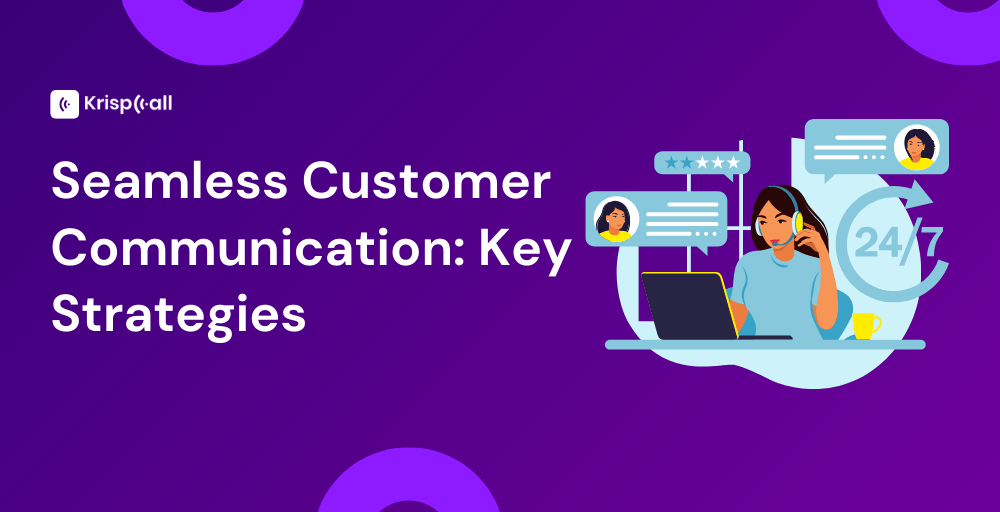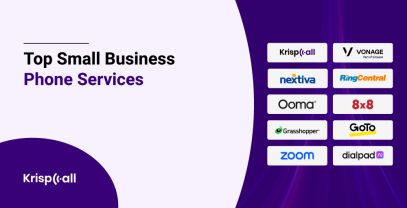Are you struggling to keep up with the volume of messages📧 from your potential customers and clients, or having difficulties addressing and tracking the customer issues? If so, Seamless Customer Communication is the best👍 solution for you.
In this article, you will learn about the definition of seamless customer communication, its benefits, and some common challenges. Additionally, we will explore digital customer trends and digital employee trends, providing a comprehensive view of the evolving landscape. Lastly, you’ll find the main part you are looking for, i.e., the key strategies for building seamless client communication.
Businesses might seek various marketing strategies to streamline communication and improve customer efficiency. So, if you want to learn about different methods to satisfy your customers and believe in your business, Let’s start immediately!
🔑Key Highlights
- Seamless Customer Communication ensures a smooth interaction flow across various channels, creating a unified customer experience without disruptions.
- Seamless Customer Communication is vital in building customer loyalty and enhancing the brand’s reputation.
- Seamless Customer Communication fosters loyalty, drives sales growth, and enhances operational efficiency.
- We have discussed the top 8 key strategies for building seamless customer communication.
- By implementing the strategies mentioned below, businesses can fortify customer relationships, elevate brand presence, and achieve a competitive market advantage.
What is Seamless Customer Communication?
Seamless Customer Communication integrates and synchronizes multiple communication channels to provide a unified customer experience, allowing customers to move between channels without interruption.
Seamless customer communication ensures that agents and customers interact smoothly and efficiently. It shapes and manages positive brand reputation and lets businesses personalize customer interactions based on preferences and behaviors. It also encourages clients and customers to participate in social media, loyalty programs, and email newsletters.
For Example, Abraham randomly browses the Internet and finds an online shoe store. Then, he decides to buy two pairs of Sneakers. But before buying them, he contacts the customer service/agent team. He has a live chat to learn more about the shoes’ manufactured date, warranty, guarantee, and other relevant information. The interaction becomes smooth and effortless, with Abraham seamlessly transitioning from the company’s website to the live chat platform without disruption.
What are the Benefits of Seamless Customer Communication?
Seamless customer communication is beneficial for the customers as well as businesses through various reasons like:
1. Enhanced Customer Engagement
Seamless customer communication allows faster responses to queries, issues, and feedback. As a result, customers are more likely to trust and recommend the brand, and customer service is more prompt and reliable.
This provides an excellent way for customers to provide quick feedback, which helps contact centers understand customer preferences, needs, and suggestions to improve their products and services further.
2. Strong Loyalty with Commitment
Another key benefit of seamless customer communication is the strong loyalty and digital customer engagement achieved by providing a responsive and personalized experience. Consistent support creates a sense of trust.
Companies or Customer Service agents can show or demonstrate empathy statements to their customers, which helps them feel valued and appreciated. This increases brand awareness among your loyal customers and makes your brand known to your loved ones.
3. Increased Brand Awareness
Seamless customer communication plays a vital role in increasing the brand’s awareness. Active social media engagement helps increase the brand’s visibility by addressing the customers’ inquiries, feedback, and concerns on social media channels.
Seamless customer communication can lead to positive reviews and testimonials. Call centers can attract new customers and audiences, expanding their reach and enhancing brand awareness.
4. Increased Sales with Enhanced Profitability
Businesses can significantly increase sales and profitability by streamlining communication channels and providing superior service. This allows sales teams to interact effectively with customers, shortening sales cycles and increasing productivity.
Contact centers can optimize customer experience marketing campaigns to better resonate with the target audience, which results in higher conversion rates and increased sales. Companies can attract new customers and target groups, expand their reach, and increase brand awareness.
5. Boosted Productivity with Enhanced Responsiveness
Seamless customer communication boosts productivity and enhances responsiveness through efficient task management. Proper project collaboration allows employees to be assigned tasks and provide timely updates.
Business teams can collaborate, share ideas, and make decisions faster by reducing network latency, integrating disparate communication tools, and leveraging automation capabilities to improve productivity.
What are the Common Challenges Faced in Seamless Customer Communication?
Some of the common challenges faced in seamless customer communication are as follows:
1. Language & Cultural Barriers
One of the most common problems and challenges is language and cultural barriers. Call centers often encounter language barriers when communicating smoothly with their customers, leading to misunderstandings.
The customer may have a language disorder such as stuttering, dysarthria, or hearing loss, making it slightly more difficult for agents to answer customer questions. Multilingual support and cultural sensitivity training can be essential solutions to this problem.
2. Insufficient Training
Inadequate training is also a significant challenge in smooth customer communication. If agents and employees are not trained in customer service techniques, product knowledge, and training skills, they may provide inconsistent or inadequate customer service.
This can lead to customer dissatisfaction due to misunderstandings and mistakes from agents and employees. Employees and agents with little or insufficient training can become demotivated, often leading to lower productivity and higher turnover. Contact centers must invest in the right training programs, technical skills, and management training to help their employees overcome challenges.
3. Scalability Issues with Growth Constraints
The growing number of businesses and acquiring more customers can often lead to scalability issues. The outdated technology in enterprises can lead to performance issues, delays, and a lack of scalability to handle large volumes of calls.
Businesses might struggle to manage customer inquiries, track communication history, and respond in a timely manner, leading to declining customer quality and dissatisfaction. Companies must invest in integration with CRM systems and workflow automation to overcome this challenge.
4. Technical Challenges
Common technical challenges such as network interruptions, compatibility issues, communication barriers, and software problems can affect smooth customer communications due to outdated technology, insufficient network resources, and inadequate IT infrastructure.
Businesses must proactively identify and resolve technical issues to minimize disruptions and maintain a high-quality communication experience.
5. Lack of Integration of CRM Tools
CRM systems are essential for centralizing customer data and facilitating personalized communications. However, many businesses may find integrating CRM tools with other systems challenging due to compatibility issues, data security issues, and integration complexity.
These can lead to inconsistent customer experiences. Call centers should invest in various CRM platforms integrating communication channels like email, chat, phone, and social media.
Key Strategies to Build Seamless Customer Communication
So, coming to the main topic of this blog, let’s talk about the key strategies that help build seamless customer communication. Some of the major points are as follows:
1. Understand your Target Audience
The first and foremost strategy to build smooth customer communication is to get to know your customers well, including their referrals, location, preferences, needs, etc. For this purpose, agents and employees should conduct market research, analyze customer data, and create customer personas to gain audience insights.
This strategy enables agents to anticipate and respond to their needs. Agents can identify common challenges by analyzing customer behavior and feedback, offer support, and develop different communication strategies to provide solutions.
2. Activate Customer Relationship Strategy with CRM System
Another vital strategy for building smooth customer communication is revitalizing your customer relationship strategy. A CRM system is a central database for storing customer data. Businesses can gain a comprehensive overview of customer profiles and interactions by integrating data.
CRM systems help businesses track customer interactions and automate communication processes. It also lets you analyze customer segmentation data, purchase frequency, and conversion rates. This allows companies to identify improvement opportunities and make data-driven decisions to drive growth.
3. Upskill and Empower staff
Further training and empowerment of employees are essential strategies for smooth communication with customers. Customer service centers must have a comprehensive training program that includes active listening, empathy, and clarity.
Technical expertise allows employees to easily navigate systems and quickly access customer data, optimizing the customer experience and maximizing productivity. Rewarding employees and recognizing them for meeting customer needs helps educate and empower employees.
4. Actively Listen to Customers’ Concerns and Feedback
Listening to customer concerns and feedback is fundamental for building seamless customer communication. Companies can identify trends and patterns so customers can adapt their products, services, and strategies to their needs.
Active listening is an essential skill when communicating with customers. Companies can respond appropriately by listening to their customers’ words, tone, and emotions and showing empathy in their communications. This strategy helps improve the quality of customer interactions and promotes a positive customer experience.
5. Improve and Adapt the Communication Strategy
Improving and adjusting your communication strategy is another key strategy for building a seamless communication agent that can evaluate customer feedback and analyze current market trends to identify areas for improvement and adjustment.
Agents and employees can deliver timely, relevant messages that enrich the customer experience. Automation and data analysis software can tailor communications to customer preferences and behavior.
6. Utilize Omnichannel Communication with a Unified Interface
Leveraging an omnichannel contact center through a unified interface is another powerful strategy for creating seamless customer communications. By consolidating all communication channels, such as phone, email, chat, and social media, into a single or unified interface, your customers can interact with your company without interruption.
Agents and employees should use live chat to quickly respond to customer inquiries and requests by providing timely assistance and support. Integrated marketing tools allow you to track customer responses and measure the effectiveness of your campaigns across all channels.
7. Personalize Customer Communications
Personalizing customer communication through call center analytics is a key strategy for building seamless customer communication. Customers will better receive personalized communication considering their preferences, needs, and interests.
Personalized communication helps build stronger customer relationships and creates a sense of connection. This helps businesses anticipate and fulfill customer needs effectively, reducing the chances of customers switching to competitors.
8.Leverage the use of Chatbots and Artificial Intelligence
The final strategy for creating seamless customer communication is to use chatbots and AI. The AI-powered chatbot improves customer interactions with its 24/7 support day and night. Immediate responses to customer inquiries reduce wait times and improve customer service experience and responsiveness.
It can use customer data to personalize customer interactions. It can tailor responses and recommendations to each individual customer by analyzing past interactions and preferences.
Conclusion
In conclusion, Seamless Customer Communication is for call centers, contact centers, and other relevant businesses facing issues and difficulties connecting with potential customers and clients.
In this digital era, Businesses can easily enhance customer engagement, loyalty, brand awareness, sales, and productivity by implementing the above-mentioned strategies. The ultimate goal of adopting the plan to build seamless customer communication is to satisfy the customers, their needs, and preferences, then have a stronger and more competitive advantage in the market.
Last but not least, These Customer communication strategies are essential for incorporating a culture of continuous improvement by reviewing and refining the communication process to adapt to innovative and evolving customer needs and new market trends.
FAQs
What are the best practices for managing customers’ feedback?
The best practice for managing customers’ feedback is actively listening and acknowledging their concerns, then following up and gathering additional insights after implementing changes.
What are customer communication techniques?
Some of the important customer communication techniques are as follows:
- Active Listening
- Multi-channel communication
- Proactive communication
- Problem Solving skills
What is customer communication management?
Customer communications management manages communication touchpoints between a company and its customers throughout the customer journey. This includes creating, delivering, and tracking various types of communications, such as customer service interactions, marketing messages, and customer notifications.





